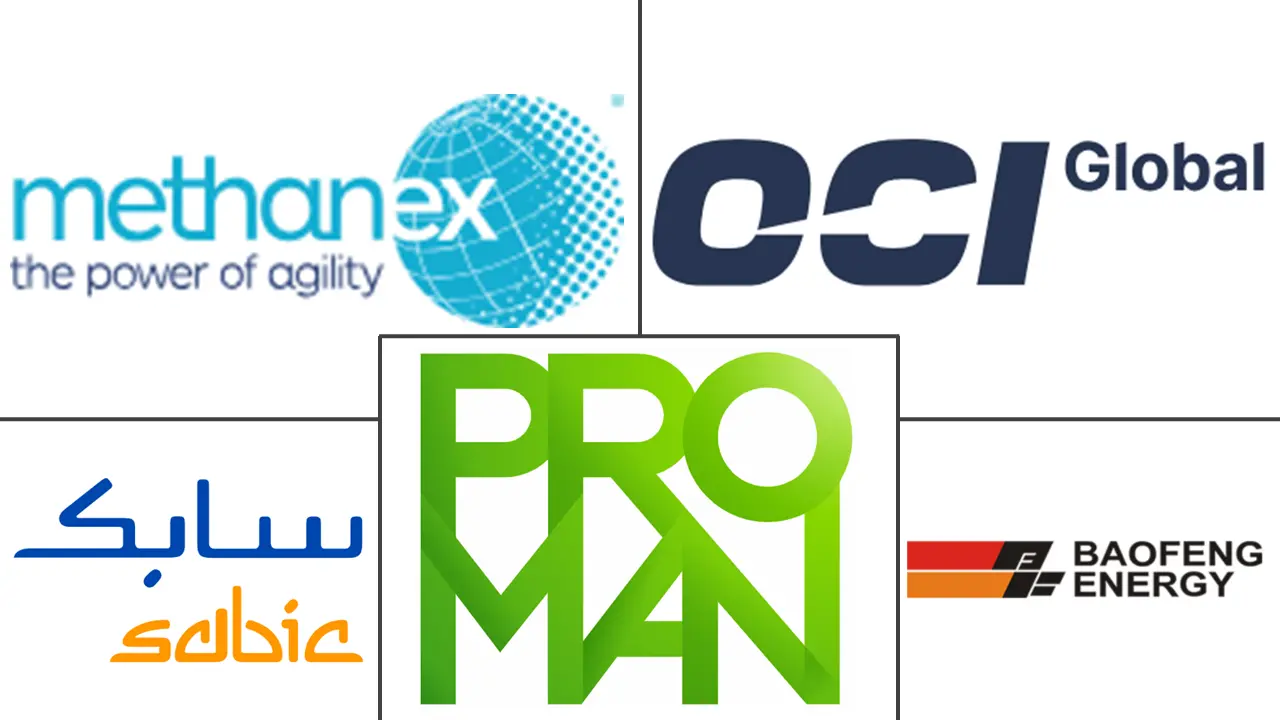Methanol Market Size and Share
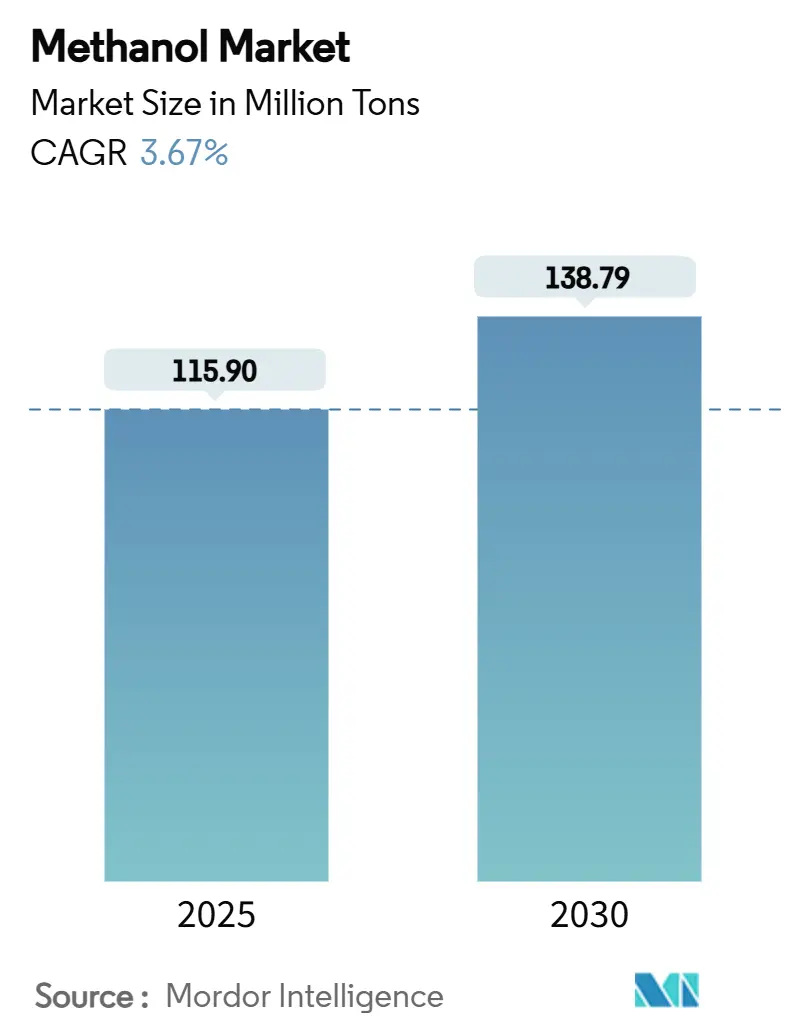
Methanol Market Analysis by Mordor Intelligence
The Methanol Market size is estimated at 115.90 Million tons in 2025, and is expected to reach 138.79 Million tons by 2030, at a CAGR of 3.67% during the forecast period (2025-2030). The headline figures hide sharp regional contrasts: Atlantic basin prices firmed after unplanned outages, while Asian spot prices softened, widening arbitrage windows for traders. China’s expanding methanol-to-olefins (MTO) capacity, North American “mega-mega” plants, and surging marine-fuel demand anchor the growth narrative. Renewable methanol projects offer sizeable upside, yet certification lags and infrastructure gaps restrict near-term supply build-out. Feedstock volatility and uneven policy support add complexity, but sustained investment in low-carbon production and shipping conversions underpin a steady medium-term trajectory for the methanol market.
Key Report Takeaways
- By feedstock, natural gas held 65% of methanol market share in 2024; renewable feedstocks are projected to post the fastest growth at an estimated 5.12% CAGR through 2030, supported by more than 210 announced projects.
- By derivative/application, energy uses captured 54% share of the methanol market size in 2024, and is projected to expand at 4.24% CAGR to 2030 on the back of aggressive dual-fuel vessel orders.
- By end-use industry, the chemical sector dominated with 66% of methanol market share in 2024; the automotive and transportation sector is forecast to record the highest 4.15% CAGR through 2030 as shipping lines decarbonize.
- By grade, chemical-grade methanol commanded 75% share of the methanol market size in 2024; fuel-grade methanol is projected to grow at 4.04% CAGR through 2030, supported by IMO emission targets.
- By geography, Asia-Pacific led with 78% share of the methanol market size in 2024, and is forecast to deliver the fastest 3.86% CAGR to 2030, leveraging low-cost shale gas and export-oriented capacity additions.
Global Methanol Market Trends and Insights
Drivers Impact Analysis
| Driver | (~) % Impact on CAGR Forecast | Geographic Relevance | Impact Timeline |
|---|---|---|---|
| Expanding Petrochemical Capacity in China, US, and Emerging Asia | +1.40% | China, United States, Southeast Asia | Medium term (2-4 years) |
| Marine Sector Transition to Low-Carbon Fuels – Adoption of Green Methanol by Global Carriers | +1.20% | Global deep-sea shipping lanes | Long term (≥ 4 years) |
| Government Mandates on Blended Fuels in ASEAN & LATAM Promoting Methanol Gasoline and DME | +0.60% | Indonesia, Argentina, Brazil, Thailand | Short term (≤ 2 years) |
| Increasing Utilization of Methanol in the Production of Olefins | +0.50% | China, South Korea, Middle East | Long term (≥ 4 years) |
| On-Purpose Propylene Deficit Strengthening Demand for Methanol-Based Routes in the Middle East | +0.40% | Saudi Arabia, United Arab Emirates, Kuwait | Medium term (2-4 years) |
| Source: Mordor Intelligence | |||
Expanding Petrochemical Capacity in China, US and Emerging Asia
Record crude throughput of 14.8 million bpd at Chinese integrated complexes in 2024 has raised methanol demand as refiners pivot toward chemical feedstocks[1]U.S. Energy Information Administration, “China sets record refinery runs,” eia.gov . Concurrently, purpose-built US “mega-mega” methanol plants are geared to serve Chinese MTO units, forging a trans-Pacific value chain that recasts traditional trade flows. Emerging Asian producers are replicating this model, with several coal-to-methanol investments under construction. These projects collectively lift regional self-sufficiency, yet they also keep incremental demand firmly tethered to methanol market fundamentals. The dynamic is expected to add around 8 million tons of new consumption by 2030, cementing Asia-Pacific’s centrality to global balances.
Marine Sector Transition to Low-Carbon Fuels
Methanol displaced LNG as the leading alternative fuel for newbuilds in 2023, when 138 methanol-capable vessels were ordered versus 130 LNG-ready ships. In early 2025, the orderbook grew by a further 23 ships, and major carriers such as Maersk now target 25 dual-fuel containerships on the water by 2027, potentially abating 1.5 million tCO₂ each year. Renewable methanol can cut lifecycle greenhouse-gas emissions by up to 95%, aligning with the IMO’s 2024 life-cycle intensity guidelines. The rapid pace of vessel commitments has outstripped realized fuel supply, underpinning firm demand expectations and reinforcing the long-term pull on the methanol market.
Government Mandates on Blended Fuels in ASEAN & LATAM
Indonesia implemented its B40 biodiesel mandate in January 2025, lifting allocated biodiesel volumes to 15.6 million kL, up from 12.9 million kL in 2024. The associated increase in FAME output materially boosts regional methanol offtake. Jakarta estimates that higher blending could save USD 9.1 billion in import costs while cutting 41.46 million tCO₂. Argentina’s revised biofuel law, targeting 1.65 billion L of biodiesel in 2024, likewise elevates demand for methanol feedstock[2]USDA Foreign Agricultural Service, “Argentina Biofuels Annual,” fas.usda.gov . Combined, such mandates introduce policy-driven growth corridors that diversify consumption beyond the petrochemical core.
Increasing Utilization of Methanol in the Production of Olefins
MTO and methanol-to-propylene (MTP) routes are eroding naphtha cracking’s dominance. Chinese coal-to-olefins lines are expected to expand at 2-3% annually from 2024, while South Korea’s S-Oil Shaheen complex will add 3.2 million tons of chemicals on stream in 2026, integrating FCC and steam-cracker technologies. Middle Eastern producers are assessing methanol-based routes as PDH margins narrow amid propane logistics disruptions. These developments are set to lift conversion demand, structurally linking olefin supply security to the health of the methanol market.
Restraints Impact Analysis
| Restraint | (~) % Impact on CAGR Forecast | Geographic Relevance | Impact Timeline |
|---|---|---|---|
| Feedstock Price Volatility | -0.80% | Europe, East Asia | Short term (≤ 2 years) |
| Slow Certification Frameworks for Green Methanol Limiting Off-take Agreements | -0.50% | Global | Medium term (2-4 years) |
| Hazardous Impacts on Health | -0.30% | Densely populated industrial hubs worldwide | Long term (≥ 4 years) |
| Source: Mordor Intelligence | |||
Feedstock Price Volatility
Natural-gas prices swung sharply in 2024 as geopolitical tensions affected European and Asian LNG benchmarks, inflating methanol production costs in import-dependent regions[3]World Bank, “Commodity Markets Outlook October 2024,” worldbank.org . Producers without secure gas supply, notably in Europe, faced compressed margins relative to plants in North America and the Middle East. The methanol market remains exposed to these swings because natural gas still accounts for 65% of feedstock. Volatility also complicates investment decisions for new capacity and hampers price transparency for downstream buyers. While hedging and integration strategies partly offset the risk, persistent instability tempers near-term growth prospects.
Slow Certification Frameworks for Green Methanol
The REDcert-EU scheme reported only 48 t of certified methanol in 2023, a dramatic fall from 9,497 t in 2022. Certification bottlenecks deter off-takers who require verifiable emissions data, especially in the maritime sector where compliance costs are rising. Although the IMO released life-cycle guidelines in 2024, regional divergences in criteria still impede harmonization. Investors remain cautious, slowing project sanctioning and delaying supply to a buoyant but credibility-conscious methanol market. Faster standardization is essential to unlock the full potential of renewable volumes.
Segment Analysis
By Feedstock: Natural Gas Dominance Faces Renewable Challenge
Natural gas accounted for 65% of total feedstock in 2024. Robust shale production in the Haynesville and Permian regions underpins cost-competitive output, ensuring reliable supply for the methanol market size. Renewable pathways—biomethanol and e-methanol—together represent 210 announced projects with potential capacity of 35.7 million t by 2030, signalling an incipient shift in the methanol industry.
Natural gas is projected to remain the anchor feedstock through 2030, but its share gradually contracts as certified green alternatives secure premiums from shipping and chemical customers. The methanol market benefits from this dual-track growth: conventional players capitalize on feedstock advantage, while early adopters of renewable technologies command higher margins and brand differentiation.
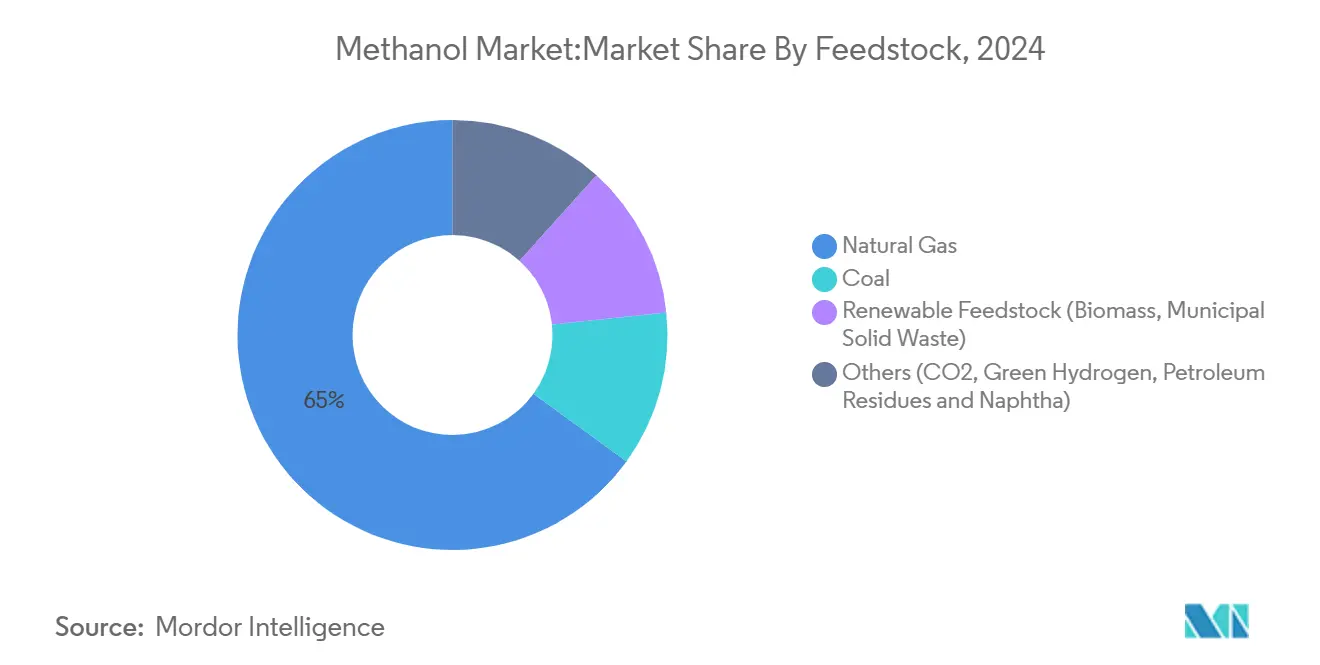
Note: Segment shares of all individual segments available upon report purchase
By Derivative/Application: Energy Applications Reshape Demand Landscape
Energy-related uses—including MTO, gasoline blending and marine fuel—captured 54% of consumption in 2024, underscoring their influence on methanol market dynamics. The methanol-to-olefins boom in China alone absorbed an incremental 4 million t in 2024, reinforcing the region’s pull on global trade.
Although currently modest in tonnage, marine fuel demand holds a significant share. Dual-fuel tonnage on order implies an additional 7 million t of annual bunker demand by 2030, indicating that the methanol market size for marine applications could rival existing energy uses. The versatility of methanol across fuels and chemicals thus smooths cyclical swings, enhancing the sector’s resilience.
By End-use Industry: Chemical Sector Maintains Strategic Importance
The chemical sector consumed 66% of global methanol in 2024, led by formaldehyde, acetic acid, and olefin derivatives. Despite the surge in energy applications, established downstream value chains secure the sector’s primacy. BASF’s partnership with Acies Bio to feed renewable methanol into fermentation platforms illustrates the sector’s pivot toward sustainable inputs.
Growing circularity requirements and specialty chemicals demand keep the chemical sector integral to the methanol market. Even as energy uses rise, the breadth of chemical derivatives ensures baseline demand, supporting capacity utilization and underpinning investment.
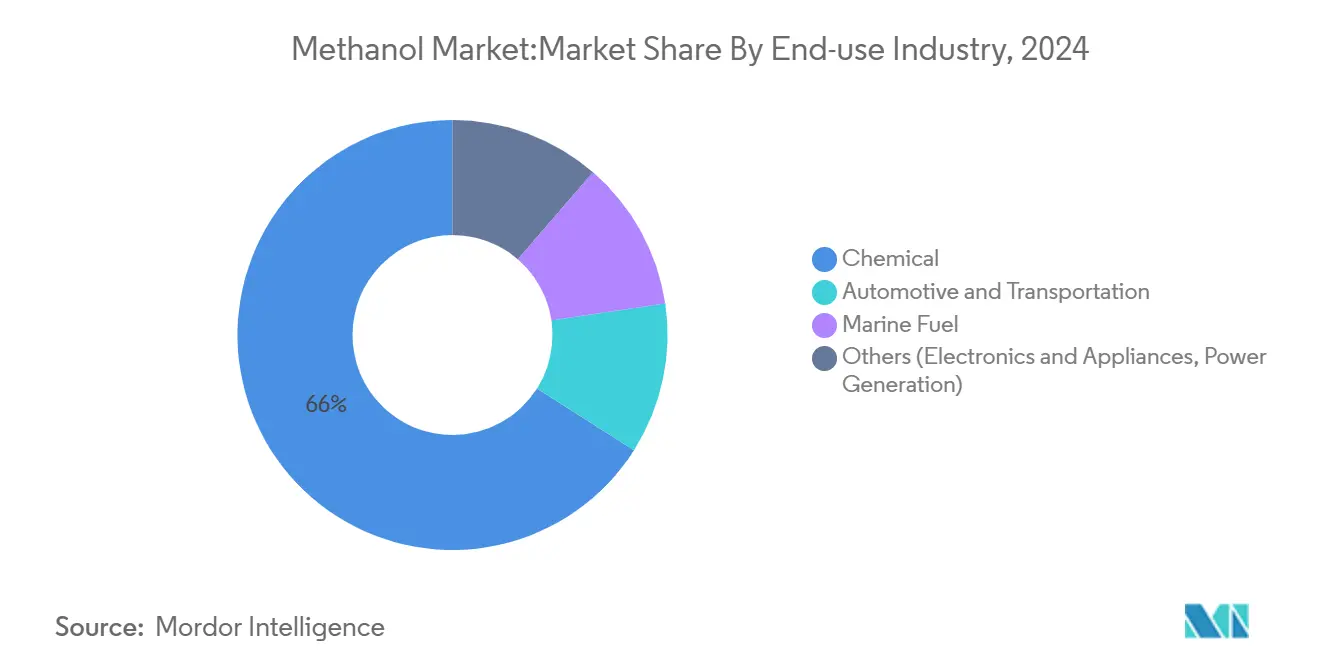
Note: Segment shares of all individual segments available upon report purchase
By Grade: Chemical Grade Maintains Market Leadership
Chemical-grade methanol commanded 75% share in 2024. Strength stems from established specifications for downstream synthesis. Fuel-grade methanol, buoyed by shipping uptake and biofuel mandates, is set to expand faster. The methanol market share of premium low-carbon grades remains small but grows rapidly as certifications improve. Fairway Methanol’s ISCC CFC accreditation in April 2024 exemplifies early success, boosting buyer confidence.
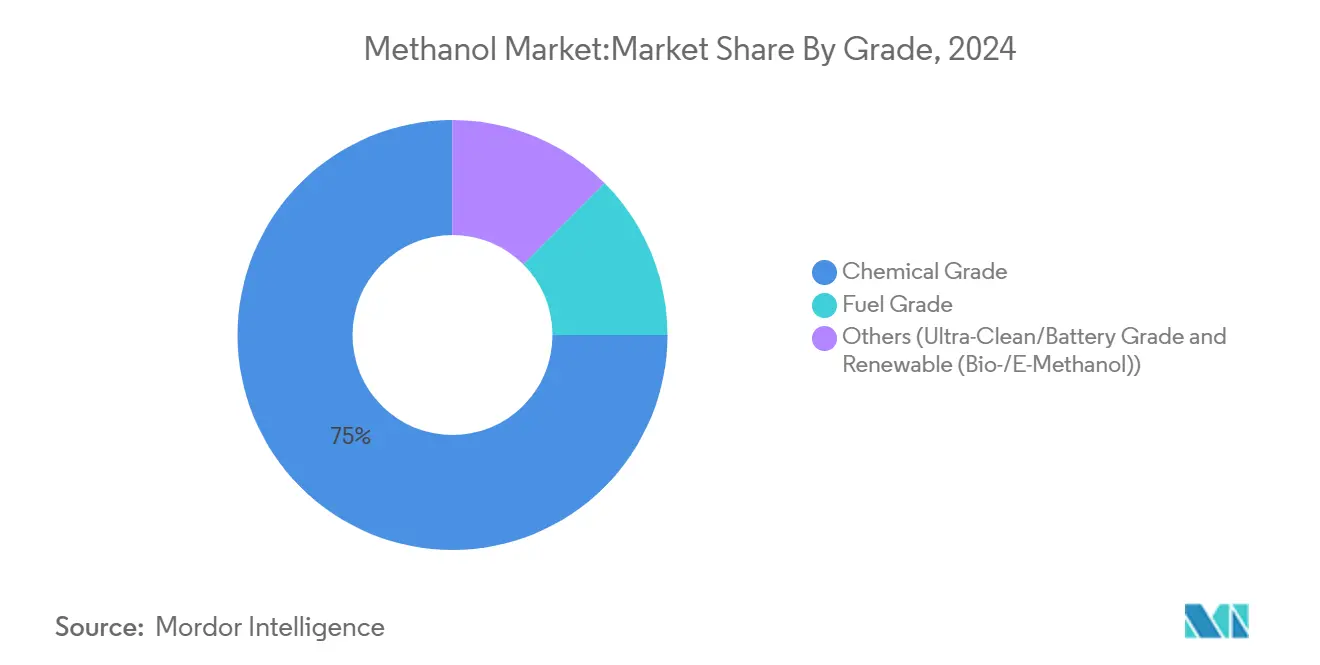
Note: Segment shares of all individual segments available upon report purchase
Geography Analysis
Asia-Pacific held a commanding 78% of global methanol consumption in 2024, equal to almost 90,400 kilotons. China’s coal-to-olefins build-out, Indonesia’s biodiesel B40 rollout and Southeast Asia’s planned capacity additions cement regional leadership. The methanol market size in Asia-Pacific is forecast to grow at 3.86% CAGR to 2030 as new demand nodes from shipping and renewable fuels augment petrochemical requirements. Regional pricing remains closely tied to Chinese import parity, making the area the bellwether for global sentiment.
North America’s role in the methanol market is undergoing transformation. Abundant shale gas underwrites a wave of export-oriented projects, typified by Lake Charles Methanol’s USD 3.2 billion complex in Louisiana. US output, once mainly for domestic formaldehyde, is now squarely aimed at Asian MTO buyers, realigning trade corridors and providing arbitrage optionality.
Europe and the Middle East illustrate divergent strategies. Europe channels investment into e-methanol to meet “Fit for 55” goals, with projects such as Forestal del Atlántico’s Spanish plant targeting shipping bunkers. Conversely, the Middle East doubles down on conventional natural-gas-based facilities, leveraging feedstock advantage to supply Asia. Together, these regions shape an increasingly bifurcated methanol market: one side chasing low-carbon premiums, the other maximizing cost leadership.
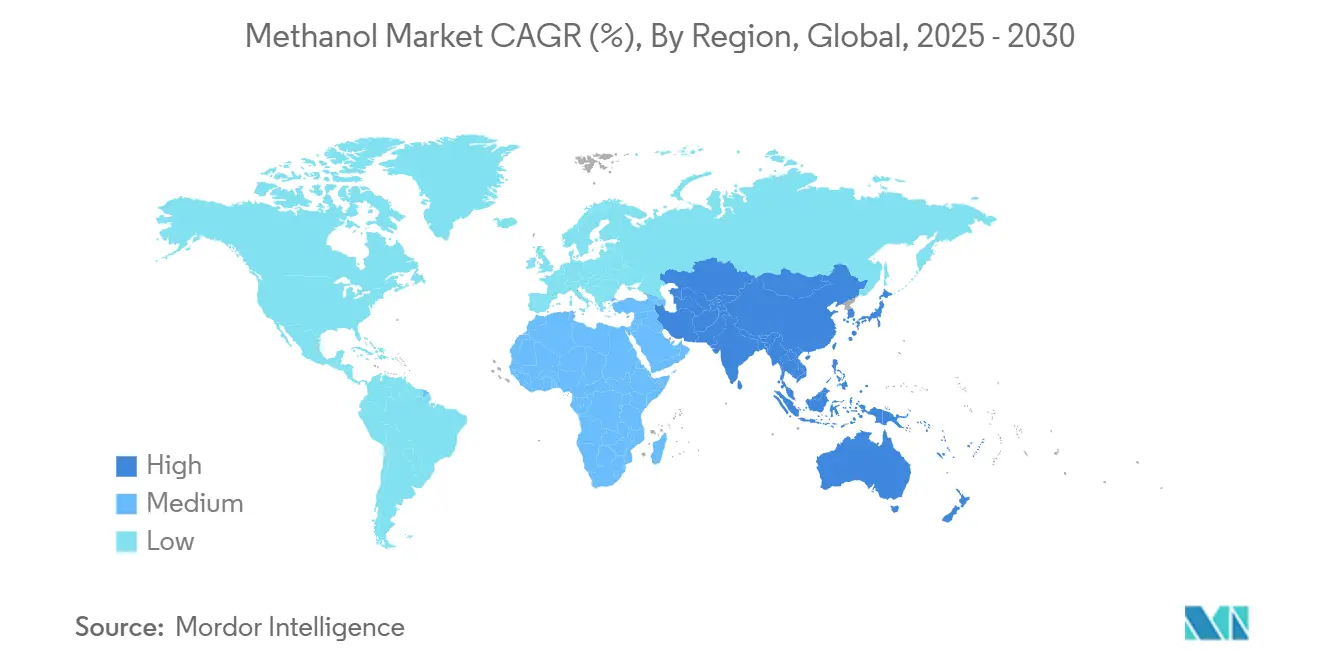
Competitive Landscape
The global methanol market is moderately fragmented, with the top five suppliers accounting for an estimated 43% combined output. Methanex’s USD 2.05 billion acquisition of OCI Global’s methanol assets in September 2024 materially strengthened its portfolio and introduced ammonia integration synergies. The deal accentuates scale as a competitive lever, prompting rivals to reassess partnership opportunities.
Strategic differentiation is pivoting toward sustainability. BASF and Envision Energy’s collaboration on e-methanol production using green hydrogen underscores the premium attached to certified low-carbon molecules. Methanex’s Pre-FEED carbon-capture study with Entropy at Medicine Hat targets a 400 tCO₂ daily reduction, further highlighting emissions as a yardstick for competitive positioning.
Regional players are likewise active. COSCO SHIPPING completed China’s first large-scale methanol bunkering operation in January 2024, moving beyond cargo to service provision. This diversification broadens revenue streams and embeds producers deeper into the downstream value chain. Overall, competition is intensifying around feedstock security, carbon credentials and downstream integration rather than pure capacity.
Methanol Industry Leaders
-
Methanex Corporation
-
OCI
-
Proman
-
SABIC
-
Ningxia Baofeng Energy Group
- *Disclaimer: Major Players sorted in no particular order
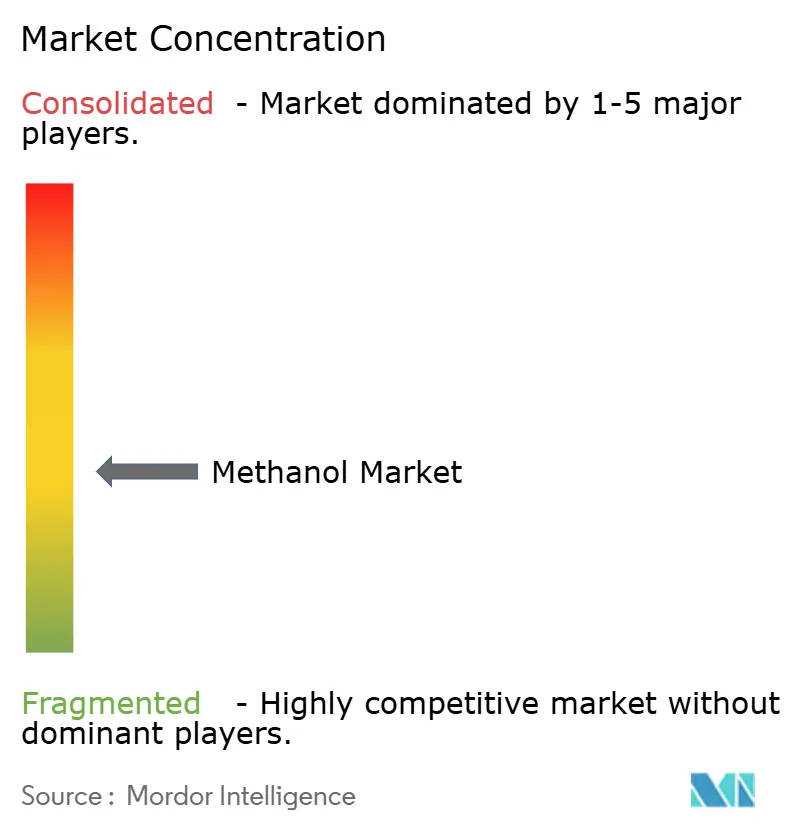
Recent Industry Developments
- November 2024: BASF has partnered with Acies Bio to utilize renewable-methanol-based fermentation technology for producing ingredients used in personal-care products, aligning sustainability with the value of specialty chemicals. This collaboration is expected to drive innovation in the methanol market.
- September 2024: Methanex has finalized a USD 2.05 billion agreement to acquire methanol assets from OCI Global, solidifying its position as the world's leading methanol marketer. This acquisition is expected to enhance Methanex's market influence and drive further consolidation within the global methanol market.
Research Methodology Framework and Report Scope
Market Definitions and Key Coverage
Mordor Intelligence treats the methanol market as the annual global output of commodity-grade CH3OH that leaves a production site for merchant sale, expressed in metric tons. Our coverage spans plants using natural-gas reforming, coal gasification, and emerging waste or biomass gasification once they reach commercial scale.
(Scope exclusion) Ultra-high-purity laboratory reagent methanol and captive volumes consumed completely inside an integrated complex are left outside the sizing.
Segmentation Overview
- By Feedstock
- Natural Gas
- Coal
- Renewable Feedstock (Biomass, Municipal Solid Waste)
- Others (CO2, Green Hydrogen, Petroleum Residues and Naphtha)
- By Derivative/Application
- Traditional Chemical
- Formaldehyde
- Acetic Acid
- Solvent
- Methylamine
- Other Traditional Chemicals
- Energy Related
- Methanol-to-olefin (MTO)
- Methyl Tert-butyl Ether (MTBE)
- Gasoline Blending
- Dimethyl Ether (DME)
- Biodiesel
- Traditional Chemical
- By End-use Industry
- Automotive and Transportation
- Chemical
- Marine Fuel
- Others (Electronics and Appliances, power generation)
- By Grade
- Chemical Grade
- Fuel Grade
- Others (Ultra-Clean/Battery Grade and Renewable (Bio-/E-Methanol))
- By Geography
- Asia-Pacific
- China
- India
- Japan
- South Korea
- Vietnam
- Thailand
- Indonesia
- Malaysia
- Australia
- New Zealand
- Rest of Asia-Pacific
- North America
- United States
- Canada
- Mexico
- Europe
- Germany
- United Kingdom
- Italy
- France
- Turkey
- Russia
- Nordics
- Spain
- Rest of Europe
- South America
- Brazil
- Argentina
- Colombia
- Rest of South America
- Middle East and Africa
- Saudi Arabia
- Qatar
- United Arab Emirates
- Iran
- South Africa
- Nigeria
- Egypt
- Rest of Middle East and Africa
- Asia-Pacific
Detailed Research Methodology and Data Validation
Primary Research
Analysts interviewed plant operators, marine-fuel distributors, formaldehyde resin buyers, and regional trade bodies across Asia-Pacific, North America, and the Middle East. Those calls clarified shadow-capacity utilization, contract pricing corridors, and the pace at which low-carbon methanol grades penetrate bunkering pools.
Desk Research
We began with public datasets on production, trade, and consumption from agencies such as the International Energy Agency, UN Comtrade, the International Methanol Producers & Consumers Association, and the US Energy Information Administration. We then layered price and capacity insights from industry periodicals and national chemical associations. Company filings gathered through D&B Hoovers, customs-level shipment traces from Volza, patent pools via Questel, and port traffic statistics helped us firm up plant commissioning dates, utilization drifts, and downstream pull. These sources illustrate our desk-work foundation and are not exhaustive.
Market-Sizing & Forecasting
A top-down balance-sheet links nameplate capacity, rolling utilization, and net exports to reconstruct apparent demand, which is then cross-checked with selective bottom-up snapshots such as sampled FOB prices multiplied by lifted cargoes. Key variables like MTO plant start-ups, coal-to-methanol economics, marine-fuel mandates, natural-gas spreads, and announced CCU projects feed a multivariate regression that generates the 2025-2030 outlook. Where bottom-up samples under-report informal trade, adjustment factors derived from primary interviews bridge the gap.
Data Validation & Update Cycle
Outputs pass variance checks against historical trade elasticities and peer ratios before a senior reviewer's sign-off. The model refreshes every year, and mid-cycle updates are triggered when feedstock prices or policy moves shift forecasts materially.
Why Mordor's Methanol Baseline Commands Reliability
Published figures often diverge because firms juggle units, feedstock scope, and refresh timing.
By anchoring on physically verifiable production and trade flows and blending that with on-ground sentiment, we reduce blind spots that pure desk models or single-source interviews leave behind.
Benchmark comparison
| Market Size | Anonymized source | Primary gap driver |
|---|---|---|
| 115.90 million t (2025) | Mordor Intelligence | - |
| USD 45.56 bn (2025) | Global Consultancy A | Values in dollars, narrower derivative list, no volume test |
| 79.2 million t (2024) | Industry Journal B | Omits coal-based plants outside Asia; uses earlier base year |
| USD 38.50 bn (2024) | Regional Consultancy C | Bundles downstream derivatives, forecasts on sales revenue |
The comparison shows that when currency swings, derivative bundling, or partial geographies creep in, totals shift markedly.
Mordor Intelligence keeps definitions tight and refresh cadence annual, giving decision-makers a transparent, repeatable baseline they can trace back to clear variables and documented steps.
Key Questions Answered in the Report
What is the current size of the methanol market?
The methanol market reached 115.90 million tons in 2025 and is forecast to grow to 138.79 million tons by 2030, implying a 3.67% CAGR.
Which region dominates global methanol consumption?
Asia-Pacific leads with 78% of global demand in 2024, driven mainly by China’s methanol-to-olefins expansion and Indonesian biodiesel mandates.
Why is methanol gaining popularity as a marine fuel?
Methanol can reduce lifecycle greenhouse-gas emissions by up to 95% when produced from renewable sources, aligning with IMO 2024 emissions-intensity guidelines and prompting rapid uptake in dual-fuel vessel orders.
What role does natural gas play in methanol production?
Natural gas supplied 65% of methanol feedstock in 2024, ensuring low-cost production in regions with abundant shale resources such as North America.
Page last updated on:
